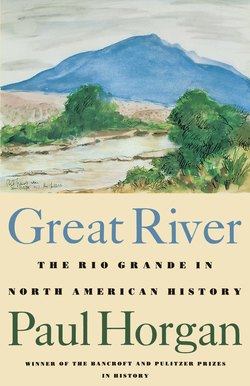Читать книгу Great River - Paul Horgan - Страница 13
На сайте Литреса книга снята с продажи.
Оглавление2.
Gazetteer
Out of such vast interaction between ocean, sky and land, the Rio Grande rises on the concave eastern face of the Continental Divide in southern Colorado. There are three main sources, about two and a half miles high, amidst the Cordilleran ice fields. Flowing from the west, the river proper is joined by two confluents—Spring Creek from the north, and the South Fork. The river in its journey winds eastward across southern Colorado, turns southward to continue across the whole length of New Mexico which it cuts down the middle, turns southeastward on reaching Mexico and with one immense aberration from this course—the Big Bend—runs on as the boundary between Texas and Mexico, ending at the Gulf of Mexico.
In all its career the Rio Grande knows several typical kinds of landscape, some of which are repeated along its great length. It springs from tremendous mountains, and intermittently mountains accompany it for three fourths of its course. It often lies hidden and inaccessible in canyons, whether they cleave through mountains or wide level plains. From such forbidding obscurities it emerges again and again into pastoral valleys of bounty and grace. These are narrow, at the most only a few miles wide; and at the least, a bare few hundred yards. In such fertile passages all is green, and the shade of cottonwoods and willows is blue and cool, and there is reward for life in water and field. But always visible on either side are reaches of desert, and beyond stand mountains that limit the river’s world. Again, the desert closes against the river, and the gritty wastelands crumble into its very banks, and nothing lives but creatures of the dry and hot; and nothing grows but desert plants of thirsty pod, or wooden stem, or spiny defense. But at last the river comes to the coastal plain where an ancient sea floor reaching deep inland is overlaid by ancient river deposits. After turbulence in mountains, bafflement in canyons, and exhaustion in deserts, the river finds peaceful delivery into the sea, winding its last miles slowly through marshy bends, having come nearly one thousand nine hundred miles from mountains nearly three miles high. After the Mississippi-Missouri system, it is the longest river in the United States.
Along its way the Rio Grande receives few tributaries for so long a river. Some are sporadic in flow. Reading downstream, the major tributaries below those of the source are Rock Creek, Alamosa Creek, Trinchera Creek and the Conejos River in Colorado; in New Mexico, the Red River, the Chama River, and four great draws that are generally dry except in storm when they pour wild volumes of silt into the main channel—Galisteo Creek, the Jemez River, Rio Puerco and Rio Salado; and in Texas and Mexico, the Rio Conchos (which renews the river as it is about to die in the desert), the Pecos River, the Devil’s River, (another) Rio Salado and Rio San Juan. The river commonly does not carry a great volume of water, and in some places, year after year, it barely flows, and in one or two it is sometimes dry. Local storms will make it rush for a few hours; but soon it is down to its poor level again. Even at its high sources the precipitation averages only five inches year-round. At its mouth, the rainfall averages in the summer between twenty and thirty inches, but there the river is old and done, and needs no new water. In January, at the source the surface temperature is fourteen degrees on the average, and in July fifty degrees. At the mouth in the same months the averages read fifty and sixty-eight. In the mountainous north the river is clear and sparkling, in the colors of obsidian, with rippling folds of current like the markings on a trout. Once among the pastoral valleys and the desert bench terraces that yield silt, the river is ever after the color of the earth that it drags so heavily in its shallow flow.
Falling from so high to the sea, and going so far to do it, the river with each of its successive zones encounters a new climate. Winter crowns the source mountains almost the whole year round, in the longest season of cold in the United States. The headwaters are free of frost for only three months out of the year, from mid-June to mid-September. Where the river carves its way through the mesas of northern New Mexico, the seasons are temperate. Entering the Texas desert, the river finds perennial warmth that rises in summer to blasting heat. At its end, the channel wanders under the heavy moist air of the tropics, mild in winter, violently hot in summer.
